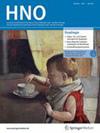[鼻腔分泌物中的免疫球蛋白 E]。
IF 0.8
4区 医学
Q4 OTORHINOLARYNGOLOGY
引用次数: 0
摘要
过敏性疾病的诊断主要通过 IgE 血液血清分析来验证。在鼻腔分泌物中进行测定在技术上较为困难,特别是由于样本量较少和样本采集方法所致。鼻腔分泌物通常采用灌洗法收集,这种方法可进行定性诊断,而使用含有一定量粘液的拭子则可进行定量分析。在皮肤和血清检测呈阴性的情况下,鼻涕中 IgE 的检测结合鼻激发试验有助于区分局部过敏性鼻炎和非过敏性鼻炎。本文章由计算机程序翻译,如有差异,请以英文原文为准。
[Immunoglobulin E in nasal secretions].
Diagnosis of allergic disease is primarily verified by IgE blood serum analysis. Determination in nasal secretions is technically more difficult, particularly due to a low specimen volume and the method of sample collection. Nasal secretions are frequently collected by lavage, which allows qualitative diagnostics, whereas swabs with defined amounts of mucus enable quantitative analyses. In the case of negative skin and serum tests, detection of IgE in nasal mucus combined with nasal provocation testing aids differentiation between local allergic and nonallergic rhinitis.
求助全文
通过发布文献求助,成功后即可免费获取论文全文。
去求助
来源期刊

Hno
医学-耳鼻喉科学
CiteScore
1.50
自引率
33.30%
发文量
116
审稿时长
4-8 weeks
期刊介绍:
HNO is an internationally recognized journal and addresses all ENT specialists in practices and clinics dealing with all aspects of ENT medicine, e.g. prevention, diagnostic methods, complication management, modern therapy strategies and surgical procedures.
Review articles provide an overview on selected topics and offer the reader a summary of current findings from all fields of ENT medicine.
Freely submitted original papers allow the presentation of important clinical studies and serve the scientific exchange.
Case reports feature interesting cases and aim at optimizing diagnostic and therapeutic strategies.
Review articles under the rubric ''Continuing Medical Education'' present verified results of scientific research and their integration into daily practice.
 求助内容:
求助内容: 应助结果提醒方式:
应助结果提醒方式:


